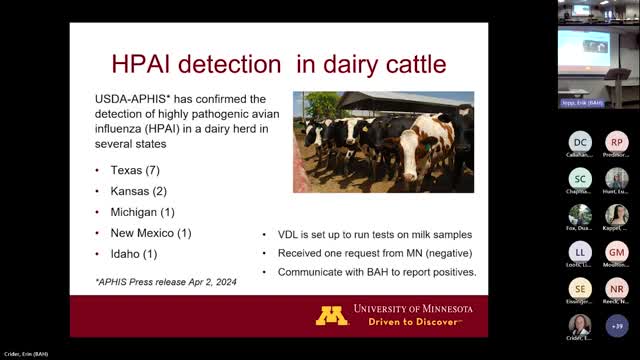Animal Humane Society supports Dog and Cat Data Transparency Bill at Minnesota legislative meeting
April 03, 2024 | Board of Animal Health, Agencies, Boards, & Commissions, Executive, Minnesota

This article was created by AI summarizing key points discussed. AI makes mistakes, so for full details and context, please refer to the video of the full meeting. Please report any errors so we can fix them. Report an error »

The Minnesota Board of Animal Health convened for its quarterly meeting on April 3, 2024, focusing on critical issues affecting animal welfare and regulatory practices in the state. A significant portion of the discussion centered around the proposed Dog and Cat Data Transparency Bill, which aims to enhance oversight of commercial breeders by making inspection reports and compliance data publicly accessible.
The meeting highlighted the importance of the veterinary diagnostic laboratory, with members acknowledging its vital role in maintaining animal health standards. The laboratory's accreditation was emphasized as crucial for the state, ensuring that Minnesota can effectively respond to potential health crises among animal populations.
A representative from the Animal Humane Society presented insights into the organization's operations, which primarily focus on sheltering and veterinary care for dogs and cats. The society's efforts to improve access to veterinary services were noted, particularly in light of the estimated 40-60% of pet owners who do not receive regular veterinary care due to various barriers. This statistic underscores the ongoing need for affordable veterinary services in the community.
The proposed legislation aims to address gaps in data transparency regarding breeders, which has been a contentious issue since the original breeder law was enacted in 2014. Currently, data on breeders is largely private, limiting the ability of consumers and regulators to assess compliance and animal welfare standards. The new bill seeks to rectify this by requiring that information such as inspection results and license statuses be made public, thereby fostering accountability and consumer trust.
Concerns were raised about the potential administrative burden this legislation could impose on the Board of Animal Health, particularly regarding the increased demand for data requests and the associated costs of maintaining public records. Board members discussed the implications of these changes, weighing the benefits of transparency against the operational challenges they may present.
In conclusion, the meeting underscored the Board's commitment to improving animal welfare through enhanced regulatory practices and transparency. As the proposed Dog and Cat Data Transparency Bill moves forward, its impact on both breeders and consumers will be closely monitored, with the potential to reshape the landscape of animal care and oversight in Minnesota. The Board anticipates further discussions and refinements to the legislation as it progresses through the legislative process.
The meeting highlighted the importance of the veterinary diagnostic laboratory, with members acknowledging its vital role in maintaining animal health standards. The laboratory's accreditation was emphasized as crucial for the state, ensuring that Minnesota can effectively respond to potential health crises among animal populations.
A representative from the Animal Humane Society presented insights into the organization's operations, which primarily focus on sheltering and veterinary care for dogs and cats. The society's efforts to improve access to veterinary services were noted, particularly in light of the estimated 40-60% of pet owners who do not receive regular veterinary care due to various barriers. This statistic underscores the ongoing need for affordable veterinary services in the community.
The proposed legislation aims to address gaps in data transparency regarding breeders, which has been a contentious issue since the original breeder law was enacted in 2014. Currently, data on breeders is largely private, limiting the ability of consumers and regulators to assess compliance and animal welfare standards. The new bill seeks to rectify this by requiring that information such as inspection results and license statuses be made public, thereby fostering accountability and consumer trust.
Concerns were raised about the potential administrative burden this legislation could impose on the Board of Animal Health, particularly regarding the increased demand for data requests and the associated costs of maintaining public records. Board members discussed the implications of these changes, weighing the benefits of transparency against the operational challenges they may present.
In conclusion, the meeting underscored the Board's commitment to improving animal welfare through enhanced regulatory practices and transparency. As the proposed Dog and Cat Data Transparency Bill moves forward, its impact on both breeders and consumers will be closely monitored, with the potential to reshape the landscape of animal care and oversight in Minnesota. The Board anticipates further discussions and refinements to the legislation as it progresses through the legislative process.
View full meeting
This article is based on a recent meeting—watch the full video and explore the complete transcript for deeper insights into the discussion.
View full meeting
